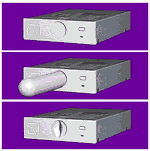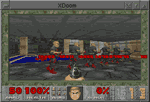|
Browser
Joes Koppers won the First International Browser Day 1998 in Amsterdam
with this "Browser". Although this work is not "up
to date", it shows one of the first internationally acclaimed
experiments in web reshaping. The browser reacts to the user's mouse
movements, interpreting them in terms of distracted or concentrated
ways of looking. Rapid, scanning mouse movements result in a "zap-state"
of browsing. Around the "focus area", the browser's integrated
search engine generates a selection of "previews" of related
sites, until the user finds something of interest and starts looking
closer, indicated by less mouse movement. It then shifts to the
"layered state", stacking a limited amount of related
sites transparently on top of each other, where they will come to
the foreground on mouse-over. The "locator" device maps
the internal structure of a given site, allowing for shortcuts not
provided by the site's own interface. When the user decides to concentrate
on one site, the browser disappears, giving the screen over to the
site's interface and content.
Joes Koppers studied graphic design at the Gerrit Rietveld Academy
in Amsterdam, and graduated with an MFA in interactive media from
the Sandberg Institute.
In 1999 Joes founded USEmedia,
an Amsterdam-based digital design studio and experimental web site.
FuckU-FuckMe
 With
FuckU-FuckMe, powerful features let users communicate sexually with
their remote partners, providing an absolutely realistic sensual
experience of real intercourse. A genitalDrive Interface is an internal
device in a standard case that can be installed in any free 5.25"
slot of a PC. The FuckU-FuckMe software connects one user's genitalDrive
with a corresponding unit on a remote PC using TCP/IP protocol.
When users start remote sexual intercourse with their partners using
FuckU-FuckMe(tm), the system will transmit all their actions to
their genitalDrive and precisely reproduce them in real time. The
system has intuitive interface and allows users to entirely concentrate
on remote communication. With
FuckU-FuckMe, powerful features let users communicate sexually with
their remote partners, providing an absolutely realistic sensual
experience of real intercourse. A genitalDrive Interface is an internal
device in a standard case that can be installed in any free 5.25"
slot of a PC. The FuckU-FuckMe software connects one user's genitalDrive
with a corresponding unit on a remote PC using TCP/IP protocol.
When users start remote sexual intercourse with their partners using
FuckU-FuckMe(tm), the system will transmit all their actions to
their genitalDrive and precisely reproduce them in real time. The
system has intuitive interface and allows users to entirely concentrate
on remote communication.
FuckU-FuckMe represents the pounding heart of Interface Research.
It was created in 1999. FuckU-FuckMe is a project by Russian web
artist Alexei Shulgin.
http://www.fu-fme.com/
Comp5
Comp5 is a 4-quicktime simulation of the radiation and motion of
gases in the trifid nebula. The two documents that are in the red
zone of the apparatus are descriptions of hydrogen explosions at
the core of the diffused nebula (notice the faster motion). The
other two documents in the black zone of the apparatus are events
at a distance of 50-100 light years away from the center of the
nebula. Comp5 is a perfect way to demonstrate what a browser or
interface is. A browser takes binary data and models it in textual
or graphical surfaces like the Web. Why not take data about gases
in some far away space nebula and present it?
Comp5 is a space interface metaphor, designed by web artist Doron
Golan in 2000.
http://www.computerfinearts.com/comp5/
CubicEye
CubicEye, one of the few commercial interface projects presented
at "InterfaceExplorer", tries to reshape the browser three-dimensionally.
The idea behind CubicEye, first presented in 2000, is to organize
the rather messy pile of web pages and applications on the computer
desktop into one coherent, easy-to-navigate cube. CubicEye users
can arrange their cubes by thematic or functional subject matter
and explore them either individually or collectively, as part of
a more comprehensive structure of multiple cubes representing not
only the desktop but various areas of interest. The tools allow
webmasters and software developers to organize their content, functions,
and interfaces into single or multiple cubes, taking advantage of
not only the surfaces of the cubes, but the space inside as well,
for the display and manipulation of both content and data.
CubicEye is a product of the New York based 2ce Company.
http://www.2ce.com/
Doom as a tool for system administration
 The
mapping of abstract operations to an intuitive environment is a
difficult task. The only widespread example is the "desktop"
interface, where files are held in "folders" which may
be "opened" or "thrown away". This is a fairly
good mapping, but does not solve all problems. The programmer of
PSDoom is proposing a new mapping for managing system loads by creating
analogies to the famous, gruesome ego shooter computer game Doom.
Since people dealing with Operating Systems frequently talk about
"blowing processes away", and the Unix command to destroy
a process is "kill", this suggests a metaphor for process
management. Each process can be a monster to be killed, and the
machines can be represented by a series of rooms through which the
first person shooter in the Doom gaming environment moves. "PSDoom",
first released in 1999/2000, is a systemically humorous way of telling
Doug Engelbart, the inventor of the "Mouse" and the "Desktop",
what administrators really want. However, even experienced system
administrators might spend days installing it... The
mapping of abstract operations to an intuitive environment is a
difficult task. The only widespread example is the "desktop"
interface, where files are held in "folders" which may
be "opened" or "thrown away". This is a fairly
good mapping, but does not solve all problems. The programmer of
PSDoom is proposing a new mapping for managing system loads by creating
analogies to the famous, gruesome ego shooter computer game Doom.
Since people dealing with Operating Systems frequently talk about
"blowing processes away", and the Unix command to destroy
a process is "kill", this suggests a metaphor for process
management. Each process can be a monster to be killed, and the
machines can be represented by a series of rooms through which the
first person shooter in the Doom gaming environment moves. "PSDoom",
first released in 1999/2000, is a systemically humorous way of telling
Doug Engelbart, the inventor of the "Mouse" and the "Desktop",
what administrators really want. However, even experienced system
administrators might spend days installing it...
Dennis Chao, designer of "PSDoom", is a Ph.D. student
in the Department of Computer Science at the University of New Mexico.
He is currently working on modeling a component of the human immune
system.
http://www.cs.unm.edu/~dlchao/flake/doom/
Fernseh-Fee/Telefairy
Telefairy is the first Analog Personal Video Recorder. The Telefairy
set top box enables viewers in Germany to compile their own TV program
from existing channels by channel-hopping and by suppressing all
commercial breaks. Telefairy, as the company's web site "telecontrol"
clearly states, is a way to use the TV as a form of rudimentary
browsing system. Naturally, the major idea is to block TV commercials
(the system zaps to another channel when a commercial block is broadcasted)
and to "protect children" from sexual and violent content
(parents may ban certain programs containing "unsuitable"
material or even scenes). It is also possible to program the Telefairy
to switch to certain genres or actors/actresses entirely by entering
titles, actors and even genres Videos are automatically recorded
without commercial breaks. The system operates with teleworkers
who constantly update TV information and send information to the
receivers. So the Telefairy workers zap for you in a non-digital
tele-service browsing system.
Telefairy is a product of the German company Telecontrol.
http://www.telecontrol.de/
Habbo Hotel
Habbo Hotel, a Finnish-British project, is a state-of-the art chatting
area. Users may inhabit the virtual five-star hotel where their
personal avatars can dance or drink the night away in one of the
many virtual clubs or bars. Habbo Hotel endeavors to bring communication
processes like "chatrooms" into an optically appealing
form. But unlike early CD-chat interfaces like "Palazzo",
the Habbo Hotel combines PC-communication with SMS and WAP technologies.
Habbo Hotel is a sophisticated communication-universe, a "social
entertainment arena".
http://www.habbo.com
|

